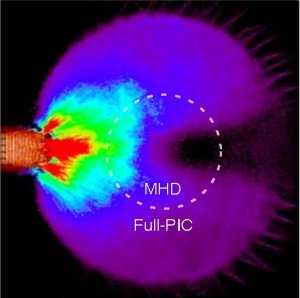Star power

In a hybrid OSIRIS simulation of fast ignition, an intense laser (orange) interacts with deuterium-tritium plasma-accelerating electrons. The red-green-blue-magenta depicts the flux of electrons that propagate through the target and are absorbed in the center of the fuel. The laser-plasma interaction is modeled with a full particle-in-cell algorithm (labeled Full-PIC); the resistive transport of electrons is modeled with a magnetohydrodynamics algorithm (MHD).
Controlled fusion technology generally takes two approaches. The first aims to confine the fuel, heated to temperatures like the sun’s, with a powerful magnetic field, usually in a donut-shaped chamber called a tokamak. The second takes advantage of inertia, using (in NIF’s case) a laser-driven implosion to squeeze the fuel, typically deuterium and tritium, to high densities and temperatures, igniting star-like energy conversions.
Inertial confinement fusion experiments are underway at NIF, Livermore’s $3.5 billion facility. Its central-hot-spot approach relies on simultaneously compressing and igniting a round fuel capsule until it implodes, much like how a diesel engine works.
The facility’s 192 intense laser beams focus on a pencil eraser-sized gold cylinder holding a BB-sized fuel pellet. The lasers make the cylinder emit X-rays that implode the pellet to a dense state capable of igniting a thermonuclear burn.
Fiuza and his colleagues are simulating another possible path. Their fast-ignition technique would separate fuel compression from ignition, he says. “Instead of compressing fuel all the way, we suggest compressing it to an even level with more relaxed constraints. Then shine another single, very intense, short-pulse laser into the fuel.” The additional ultra-fast laser pulse would accelerate high-energy electrons, transferring energy to the fuel’s center and heating it enough to trigger a fusion burn, even with the milder initial compression.
The catch: “We don’t yet have the short-pulse laser that would allow us to reach ignition conditions. This is a very complex process. So we need to understand very well how such intense lasers would interact with the fuel and generate these electrons.”
Fiuza’s simulations will employ the hybrid OSIRIS version he developed during doctoral work split between his home school, Lisbon’s Instituto Superior Tecnico (IST), and a guest stint at UCLA.
OSIRIS, developed jointly by UCLA and IST researchers for more than a decade, is based on a particle-in-cell (PIC) algorithm. PIC codes model the behavior of plasmas by computing on a grid the motions of individual charged particles under the effect of electromagnetic fields.
OSIRIS’ ability to flexibly describe complexities like laser-plasma interactions is crucial to modeling fast ignition. But a standard PIC code can’t simulate everything that happens where laser beams meet fuel pellets, Fiuza says. For example, fuel capsule sizes “are on the order of a millimeter, but to fully understand everything going on you have to also capture the motions of charged particles that populate the plasma, which can be down to the scale of an atom,” he says. “So we have many orders of magnitude difference between the largest and the smallest scales we need to capture to accurately model everything that is going on in our system.”
To address this multiscale problem, his Livermore colleagues proposed a hybrid algorithm Fiuza implemented in OSIRIS that modifies calculations in a fuel pellet’s environs.
“Our goal with this project is for the first time to capture all of this in a self-consistent way, and if possible in 3-D,” he says.
About the Author
Monte Basgall is a freelance writer and former reporter for the Richmond Times-Dispatch, Miami Herald and Raleigh News & Observer. For 17 years he covered the basic sciences, engineering and environmental sciences at Duke University.




